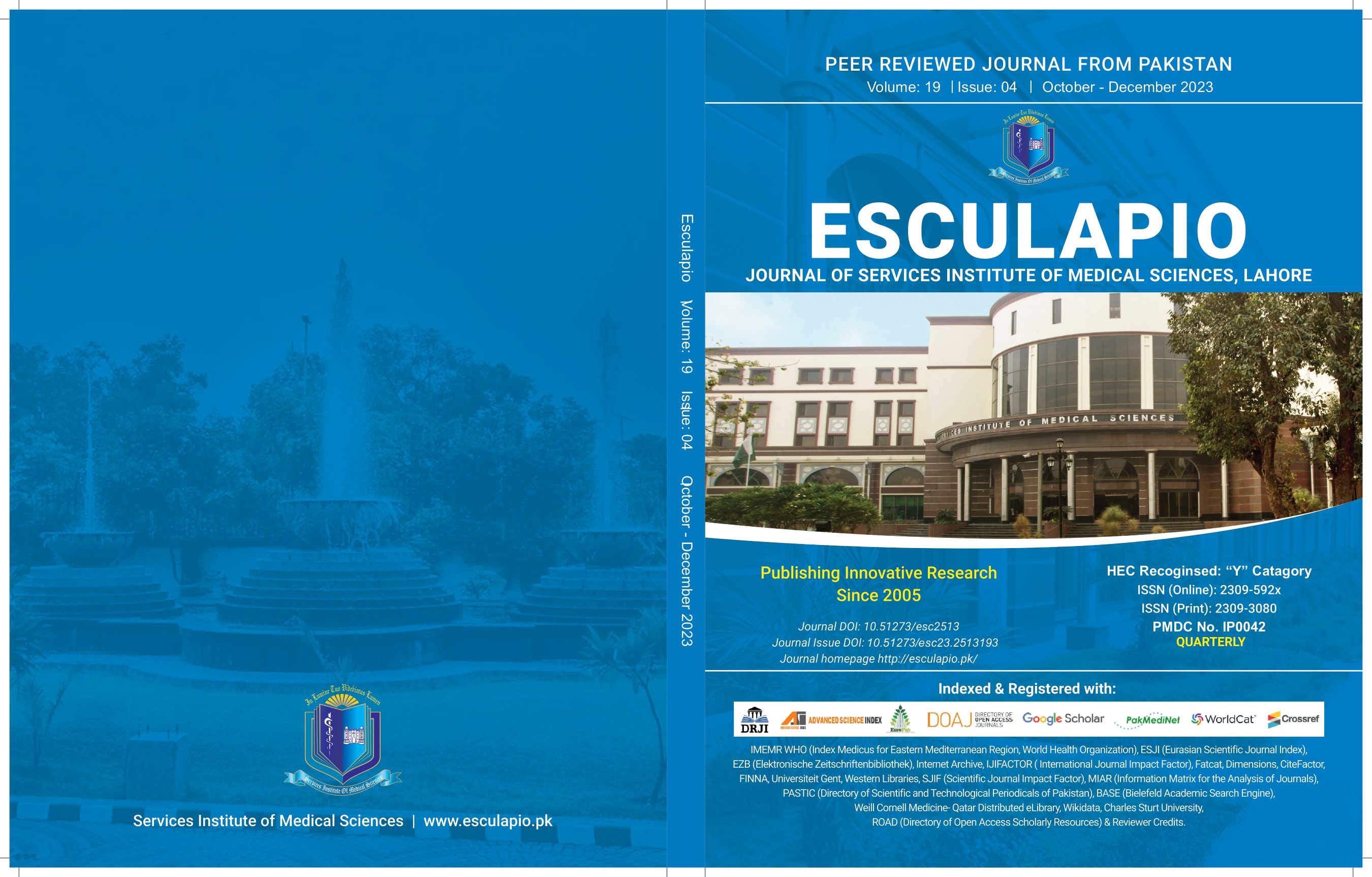Comparison of Serum Hepcidin Levels Between Anaemic and Non-anaemic Obese Young Adults
DOI:
https://doi.org/10.51273/esc23.25131947Keywords:
Obesity, Hepcidin, Anaemia, Haemoglobin, Iron DeficiencyAbstract
Objective: To compare the levels of serum hepcidin between anaemic and non-anaemic obese adults aged between 18 and 40 years.
Material and Methods: The comparative cross-sectional study was conducted at Department of Physiology, King Edward Medical University, Lahore during July 2017 to June 2018. A sample size of 82 subjects (41 in each group) was calculated. After approval from the ethical review committee and taking informed consent, 82 volunteers fulfilling the criteria were recruited in this comparative cross-sectional study. Personal biodata and anthropometric measurements were recorded. Haemoglobin and hepcidin levels were estimated. Based on presence of anaemia, volunteers were divided into 2 groups of 41 participants each: anaemic obese and non-
anaemic obese. Comparison of these two groups and statistical analysis of the data was done using SPSS (Version 23).
Results: On comparison of anaemic obese and non-anaemic obese groups, no significant difference was found in hepcidin levels between two groups. On comparison of serum hepcidin levels with respect to grades of obesity, hepcidin levels were found significantly high in anaemic obese group as compared to non-anaemic obese group at BMI greater than 40. On comparison of serum hepcidin levels between two groups with respect to gender, anaemic obese females have low hepcidin levels than non-anaemic obese females while anaemic obese males have higher hepcidin levels than non-anaemic obese males.
Conclusion: At higher BMIs, presence of higher hepcidin levels in anaemic obese group shows its probable role in development of anaemia in the presence of morbid obesity but no such correlation could be established at lower BMIs. Moreover, presence of low levels of hepcidin in anaemic obese females hints towards the nutritional cause of anaemia in anaemic obese females rather than inflammation and hepcidin.
References
GBD 2021 Anaemia Collaborators. Prevalence, years lived with disability, and trends in anaemia burden by severity and cause, 1990–2021: findings from the Global Burden of Disease Study 2021. The Lancet Haematology. 2023 Sep 1;10(9):e713-34.
Kumar A, Sharma E, Marley A, Samaan MA, Brookes MJ. Iron deficiency anaemia: pathophysiology, assessment, practical management. BMJ open gastroenterology. 2022 Jan 1;9(1):e000759.
Leung AK, Lam J, Wong AH, Hon KL, Li X. Iron deficiency anemia: An updated review. Current Pediatric Reviews. 2023 Jul 27.
Ganz T. Anemia of inflammation. New England Journal of Medicine. 2019 Sep 19;381(12):1148-57.
Camaschella C, Nai A, Silvestri L. Iron metabolism and iron disorders revisited in the hepcidin era. Haematologica. 2020 Feb;105(2):260.
Ilesanmi-Oyelere BL, Schollum L, Kuhn-Sherlock B, McConnell M, Mros S, Coad J et al. Inflammatory markers and bone health in postmenopausal women: a cross-sectional overview. Immunity & Ageing. 2019 Dec;16(1):1-2.
Nirengi S, Taniguchi H, Ishibashi A, Fujibayashi M, Akiyama N, Kotani K et al. Comparisons between serum levels of hepcidin and leptin in male college-level endurance runners and sprinters. Frontiers in Nutrition. 2021 May 31;8:657789.
Praeger-Jahnsen L, Magnussen K, Schiødt FV, Therkildsen RC, Jørgensen N, Friis-Hansen L. A novel hepcidin mutation. Transfusion Clinique et Biologique. 2023 Mar 15.
Nemeth E, Ganz T. Hepcidin-ferroportin interaction controls systemic iron homeostasis. International journal of molecular sciences. 2021 Jun 17;22(12):6493.
Chambers K, Ashraf MA, Sharma S. Physiology, Hepcidin. 2023 Apr 17. In: StatPearls [Internet]. Treasure Island (FL): StatPearls Publishing; 2023 Jan–. PMID: 30855845.
Varga E, Pap R, Jánosa G, Sipos K, Pandur E. IL-6 regulates hepcidin expression via the BMP/SMAD pathway by altering BMP6, TMPRSS6 and TfR2 expressions at normal and inflammatory conditions in BV2 microglia. Neurochemical research. 2021 May;46(5):1224-38.
Cepeda-Lopez AC, Zimmermann MB, Wussler S, Melse-Boonstra A, Naef N, Mueller SM et al. Greater blood volume and Hb mass in obese women quantified by the carbon monoxide-rebreathing method affects interpretation of iron biomarkers and iron requirements. International Journal of Obesity. 2019 May;43(5):999-1008.
Rohm TV, Meier DT, Olefsky JM, Donath MY. Inflammation in obesity, diabetes, and related disorders. Immunity. 2022 Jan 11;55(1):31-55.
Berton PF, Gambero A. Hepcidin and inflammation associated with iron deficiency in childhood obesity-A systematic review. Jornal de Pediatria. 2023 Aug 1.
Alshwaiyat NM, Ahmad A, Al-Jamal HA. Effect of diet-induced weight loss on iron status and its markers among young women with overweight/obesity and iron deficiency anemia: a randomized controlled trial. Frontiers in nutrition. 2023 May 22;10:1155947.
Nemeth E, Ganz T. Hepcidin and iron in health and disease. Annual review of medicine. 2023 Jan 27;74:261-77.
Pagani A, Nai A, Silvestri L, Camaschella C. Hepcidin and anemia: a tight relationship. Frontiers in physiology. 2019 Oct 9;10:1294.
Nazif HK, El-Shaheed AA, El-Shamy KA, Mohsen MA, Fadl NN, Moustafa RS. Study of serum hepcidin as a potential mediator of the disrupted iron metabolism in obese adolescents. Int J Health Sci (Qassim). 2015;9(2):172-178.
Sanad M, Osman M, Gharib A. Obesity modulate serum hepcidin and treatment outcome of iron deficiency anemia in children: A case control study. Ital J Pediatr. 2011;37:34. doi: 10.1186/1824-7288-37-34.
Przybyszewska J, Żekanowska E, Kędziora-Kornatowska K, Boinska J, Porzych K, Przybyszewski M, et al. Comparison of serum prohepcidin and iron metabolism parameters in obese and non-obese elderly individuals. Endokrynol Pol. 2013;64(4):272-277. doi: 10.5603/EP.2013.0005.
Vyas S, Kapoor A, Nema S, Suman S. Quantification of serum hepcidin as a potential biomarker in diagnosis of iron deficiency anaemia. Int J Res Med Sci. 2017;5(7):2926-2930. doi: 10.18203/2320-6012.ijrms20172546.










